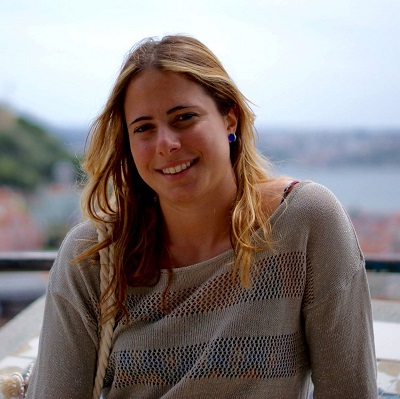Two-part seminar: (1) Mapping the tumour heterogeneity with multiparametric MRI: changing the paradigm of radiotherapy treatments of brain cancer and (2) Inorganic microcapsules for protection and efficient delivery of small molecule cargo
This seminar will be presented together by the following presenters starting with Dr Caterina Brighi and followed by Dr Alison White. Please see all information below for full details of this seminar.
Dr Caterina Brighi, MRes, PhD, Postdoctoral Research Associate,
ACRF Image X Institute, Central Clinical School, Faculty of Medicine and Health,
The University of Sydney, presents:
Mapping the tumour heterogeneity with multiparametric MRI: changing the paradigm of radiotherapy treatments of brain cancer
 Abstract: Glioblastoma (GBM) is one of the most aggressive types of brain cancers with an extremely poor five-years survival rate of 5.1%. Improving clinical outcome for GBM is difficult, due to the highly heterogeneous nature of this tumour. Information on the biological diversity within the tumour lesion is not incorporated into current radiotherapy treatment (RT) plans, leading to “one size fits all” treatment approach that has proven to be ineffective, as the majority of tumours recur locally after a few months following standard treatment. An opportunity to improve the standard of care of glioblastoma patients lies in the development of an imaging biomarker for infiltrating tumour. This would result in a more accurate definition of the target volume in RT planning, thereby allowing RT plans to be adapted to deliver higher doses selectively to the biologically active tumour and to spare unnecessary treatment to healthy brain tissue with a “dose-painting” approach.
Abstract: Glioblastoma (GBM) is one of the most aggressive types of brain cancers with an extremely poor five-years survival rate of 5.1%. Improving clinical outcome for GBM is difficult, due to the highly heterogeneous nature of this tumour. Information on the biological diversity within the tumour lesion is not incorporated into current radiotherapy treatment (RT) plans, leading to “one size fits all” treatment approach that has proven to be ineffective, as the majority of tumours recur locally after a few months following standard treatment. An opportunity to improve the standard of care of glioblastoma patients lies in the development of an imaging biomarker for infiltrating tumour. This would result in a more accurate definition of the target volume in RT planning, thereby allowing RT plans to be adapted to deliver higher doses selectively to the biologically active tumour and to spare unnecessary treatment to healthy brain tissue with a “dose-painting” approach.
As the heterogeneous nature of GBM tumours results in different physiological footprints of different areas of the tumour, an accurate diagnosis of tumour cells infiltration most likely requires the combination of multiple rather than a single imaging modality. In the last decade, several studies focusing on the development of multiparametric MRI (mpMRI) models to predict the probability of tumour infiltration beyond the core tumour mass have been published. While these studies have mainly focused on the development and testing of the models’ accuracy, they have only speculated on the possible applications of these models into clinical practice. My work focuses on exploring the feasibility of integrating mpMRI models of tumour infiltration into RT planning. I am interested in evaluating the repeatability of RT dose plans obtained from mpMRI-derived maps of probability of tumour infiltration, and in assessing whether using these dose plans in a dose-painting approach would lead to improved local tumour control compared to standard clinical RT plans.
Dr Alison White, MChem (Hons), CChem, PhD, Research Fellow,
Australian Institute for Bioengineering and Nanotechnology, University of Queensland, presents:
Inorganic microcapsules for protection and efficient delivery of small molecule cargo
 Abstract: Polymer microcapsules are utilised as a carrier of active ingredients across a wide range of applications, including pharmaceuticals, agrochemicals, personal care, home care, foods and paints. Encapsulation is a popular mechanism to allow for protection of the active ingredient and for controlled release, however, due to the inherent permeability of a polymer shell, and despite recent advances such a material is unsuitable to retain small, volatile molecules for periods of time longer than a few days.
Abstract: Polymer microcapsules are utilised as a carrier of active ingredients across a wide range of applications, including pharmaceuticals, agrochemicals, personal care, home care, foods and paints. Encapsulation is a popular mechanism to allow for protection of the active ingredient and for controlled release, however, due to the inherent permeability of a polymer shell, and despite recent advances such a material is unsuitable to retain small, volatile molecules for periods of time longer than a few days.
Recently, we have demonstrated that growth of a continuous secondary gold shell onto polymer microcapsules can allow for complete retention of small molecules. Gold shells are grown via an electroless deposition reaction using platinum nanoparticles adsorbed to the polymer microcapsule surface as catalytic loci for the reaction. However, gold is a precious metal and as such, whilst this secondary shell shows promise in preventing the age-old problem of capsule leakage, it is an expensive solution, lending itself only to high-end applications such as drug delivery. By using cost-effective shell materials these microcapsules can become more attractive to the wider market.
The work presented here explores the controlled deposition of impermeable metal and mineral shells and mechanisms to trigger release in a controlled manner.
About CAI Seminar Series
The perfect opportunity to attend cutting-edge research presentations involving CAI researchers or collaborators, each Tuesday at 9:30am in the CAI Seminar Room, entry via CAI main doors, facing Wep Harris oval (see map).
If you would like weekly email notification for the seminar series or are interested in presenting, please contact CAI Enquiries.
*Our seminar series is now online! See our listed sessions to read more about our upcoming webinars.
To watch previous sessions, press the button below.
